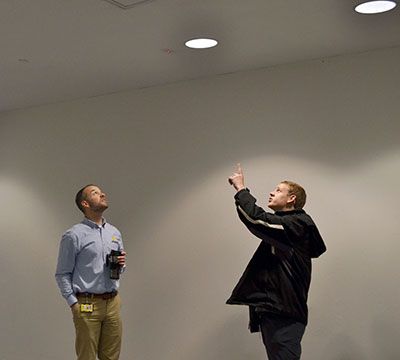Revolving Energy Fund & Energy Conservation
Energy conservation measures are a part of the university’s demand-side energy management strategy to achieve its carbon neutrality goals.
An energy conservation measure (ECM) reduces the energy consumption of a particular piece of equipment or a certain aspect of essential building services to reduce overall building energy use.
Demand-side energy management encompasses various methods for modifying consumer energy use. These include technological improvements, financial incentives, operational efficiency, and behavior change.
Prioritizing investments in ECMs is important because:
- The easiest way to conserve energy is to not use it in the first place;
- Reducing energy consumption lowers operating costs and carbon emissions; and
- Energy conservation reduces the amount of renewable energy that the university needs to generate and procure to achieve carbon neutrality.
ECMs help to reduce both U-M’s Scope 1 and Scope 2 emissions.

Investments in easy-to-implement ECM projects
To support ECM projects across all U-M campuses (Ann Arbor, Dearborn, Flint) and auxiliary units (Athletics, Michigan Medicine, and Student Life), U-M has established a university-wide revolving energy fund (REF). The REF has $25 million in seed funding to be dispersed over the next five years toward ECM project costs. Its establishment was one of 50 recommendations put forth by the President’s Commission on Carbon Neutrality (PCCN).
A revolving energy fund (REF) is an internal investment vehicle that provides financing to parties within an organization for implementing energy conservation measure (ECM) projects that generate cost savings. The savings are paid back over time to replenish the fund and support future energy conservation projects, thus establishing a sustainable funding cycle while cutting operational costs and reducing environmental impact.

More than 65 projects have been completed, selected for funding, or are in progress across the Ann Arbor, Dearborn and Flint campuses.
Learn more about the Ann Arbor campus projects from the U-M Ann Arbor Office of Campus Sustainability (OCS). In addition to the revolving energy fund projects, OCS continues its energy conservation work, building on efforts dating back to the establishment of the first U-M energy engineer role in 1990.
Building Standards
Building on work from the PCCN that analyzed the nexus between carbon neutrality and building standards, a U-M implemented new low-carbon standards for new construction and major renovations. These standards will reduce life-cycle carbon emissions and improve energy efficiency in campus buildings, innovating beyond existing guidelines, such as ASHRAE +30 and LEED Silver.
AEC applies sustainable design standards to construction projects. Nineteen U-M buildings have achieved LEED certification for maximizing energy efficiency and incorporating other sustainability measures.